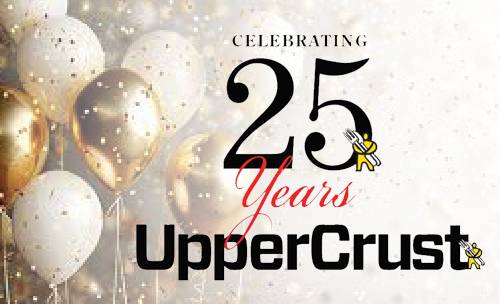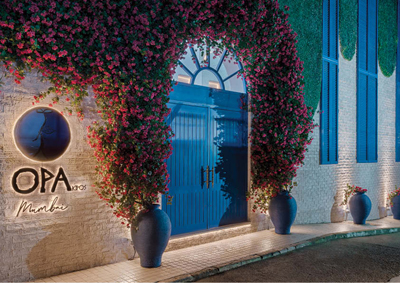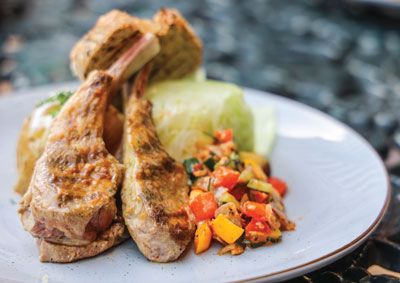Spit and Polish and New
Spit and Polish and New
In its brand new avatar, Bombay Brasserie is a delicious spot to patronise. Art Deco feel intact, the food takes a diner on a delightful trip, Kashmir to Kanyakumari and from Bombay to Calcutta
Text: Dr Nishant Kumar

From the people who have brought us the much loved and celebrated Copper Chimney, there is a new eatery in town – Bombay Brasserie. In its new avatar, located over two floors at the iconic Art Deco Dhanraj Mahal, the architects have done a marvellous job of making the place look much bigger than it is. An 80-seater restaurant – the décor has lots of character keeping the Art Deco influences intact. A staircase divides the space into two and there is a charismatic Art Deco bar, which forms the centrepiece of this restaurant. The layout is spacious and I was surprised that this is actually an 80-seater restaurant. At no stage do you feel cramped in and this is largely due to the double-height ceiling, which gives the impression of space. I enjoyed the small tributes in the décor to our Bombay dabbawalas and there are some wonderful representations of Indian art from across the country. The centrepiece on the double-height ceiling is an abstract work with possibly kites, but is non-intrusive and actually livens up the place.
Karan Kapur, the scion and heir to the restaurant business of the ever-affable and renowned restaurateur of Bombay, Sunil ‘Joy’ Kapur, tells me that this has been a project, which the whole team has been working on for a while. The idea was to have a restaurant, which showcased the best from all over the country. So, they have taken their time to research the most well-known and characteristic dishes from across the length and breadth of the country and have tried to ensure that the main ingredients for each dish come from the region, which the dish represents.
It’s a very different take from their popular Copper Chimney restaurant, which is a favourite for most in the city and our go-to place for Indian food. This restaurant carves out a new niche taking the diner on a culinary journey from Kashmir to Kanyakumari and from Bombay to Calcutta.
They have an extensive collection of cocktails, mocktails and a lot of these are done with a desi twist. I had the Anguri Soda, which is a combination of fizzy club soda with black grape juice, cumin, lemon and curry leaves and the Keri Mojito, which is a twist on a traditional mojito made with curry leaves and having the distinctive kacchi keri tang to it.
The menu is extensive with lots of options for vegetarians and non-vegetarians.
From their small plates, which are actually quite well-portioned, we tried the Guntur Podi Chicken, the Smoked Madras Lollipop and the Fiery Thecha Prawn. As I mentioned, there is something from every part of India, so the choice is extensive and sensibly curated.
The Podi Chicken is a hot and spicy fried chicken with the typical podi masala from Andhra Pradesh served with a curry leaf dip. I found the chicken to be moist and succulent and the podi dressing, which is unusual over a chicken, was very well- judged; and with the curry leaf dip, it was a great way to start a meal.
The Smoked Madras Lollipop was again a variation on the typical chicken lollipop, which we are used to, except here, the chef told me the main ingredient is chilli and tamarind brought from Madhya Pradesh. I enjoyed the spice and the tanginess of the tamarind in this dish. Thecha, a very familiar dish to most of us in Bombay, is a signature dish for Bombay Brasserie. The prawns are tossed with the thecha masala, which is essentially green chillies and peanuts, however, for me, I thought the prawns were slightly overcooked and thecha lacked the punch which one expects.
Our next course was a selection from their hot plates and street grills. We were advised to taste the Kashmiri Naan Kebab, the Rajputana Murgh Soola and the Galouti Kebab along with the Banana- Leaf Wrapped Grilled Fish. Of all of the above the Kashmiri Naan Kebab was my favourite – good quality mutton mince infused with flavours from the Valley served on naan bread with a Kashmiri-inspired creamy yogurt dip with walnuts. The lamb is succulent, tender and intensely flavourful. Minced lamb, again, good quality, has an earthy and meaty texture and flavour to it where very little needs to be done. Most kebabs overdo the spicing and actually kill the flavour of the meat rather than accentuate it. At Bombay Brasserie this is a dish which is highly recommended.
The Rajputana Murgh Soola is a twist on the typical tikka where the masalas have been brought in from old recipes of the Rajput warriors. The one thing that the experts at Copper Chimney know how to do is kebabs. This is no exception with the chicken being tender and has a melt-in-the-mouth quality. The galouti is now ubiquitously available everywhere which is mutton ground very finely combined with typical Awadhi spices. The version in Bombay Brasserie did not have the intense flavouring, which one enjoys in a good galouti, and is slightly coarse. The Banana- Leaf Wrapped Grilled Fish, served with rawas is a typical Kerala preparation with curry leaves, fennel leaves and a tomato-based masala, was slightly overcooked affecting the texture of the dish.
For the main course, we had the Smoked Jodhpur Mutton, Toddy Shop Fish Curry and Mutton Boti Biryani served with chur chur paratha and rumali roti. The Jodhpur Lamb is a variation on the laal maas using the Mathania chillies, which are sourced from Jodhpur for this dish. The smokiness of the dish with the pungency and sweetness of the chillies was a treat for the taste buds. Sometimes, all one tastes in laal maas is the heat of the chilli which is not what laal maas is about. The Mathania chilli has a heat, pungency and sweetness which makes this dish special. It is very difficult to replicate the quality of meat that one gets in Rajasthan and possibly the best laal maas I have tried was with Bapji Gaj Singh, the erstwhile ruler of Jodhpur, when we were his guests at Umaid Bhawan. Though the ingredients can now be imported from Jodhpur, there is something yet secretive about this recipe, which is served best when you are with the true Rajputs.
The Toddy Shop Fish Curry was again a rawas-based fish curry with coconut, black tamarind, and the chef informed me that this dish is cooked in a traditional earthen pot called a manchatti, which has been brought from Kerala especially for this dish. The Mutton Boti Biryani was a dum pukht-style biryani where the flour roti lid was cut on the table releasing the wonderful aromas of a slowly-cooked dum biryani. For biryani lovers I am sure they will not be disappointed. The chur chur paratha is something which is not easily available. The easiest way to describe this is it is like a lachha paratha, but much more crispy, flaky and layered, and then hand-crushed before it is delivered on the table. It’s a wonderful Indian bread and a must-try here.
For dessert, we tried the Amritsari Kulfa and the Ras-e-Aam. The kulfa is a traditional kulfi served with rabdi and a bed of badami phirni finished with falooda and a little bit of rose syrup. It is the simple pleasures of life that are sometimes so enjoyable. Good kulfi with creamy rabdi and nice falooda is something that brings a smile to the face of even those with the most sophisticated and discerning palate.
The Ras-e-Aam, which is a new concoction of Bombay Brasserie – essentially a rasgulla served with rabdi and topped off with aamras. It’s a combination which could work well; however, the rasgulla consistency was far too stodgy to make this dish memorable.
Certain dishes like the Kashmiri Naan Kebab, Guntur Podi Chicken and Mutton Boti Biryani stand out and would give competition to any of the best restaurants in the city. The ambience is lively, and visiting Dhanraj Mahal, which is one of the celebrated Art Deco buildings of Bombay, is always a pleasure. Some dishes need a little more work and attention; however, a meal at Bombay Brasserie allows you to travel the length and breadth of the country while sitting in a cosy corner in South Bombay.
Prices are moderate with the most expensive dishes being less than Rs 900 and most vegetarian dishes ranging between Rs 400-600. Portions, as I mentioned, are quite generous and sufficient for two to three people. A meal for two with a choice of small plates, grills and a main course with dessert will set you back about Rs 3000, which, given the quality of the food, the ambience and the location, is great value.
It is often a question I ask myself, my friends and fellow food patrons, as to where do you take somebody if you want to go for a good Indian meal in Bombay. It’s surprising that despite the myriad restaurants one really struggles to find a place which has great ambience, good Indian food and an extensive menu to satisfy almost everyone. If you think about it you will notice that you start struggling to count the places that you would highly recommend if someone visited the city and you want to showcase the best of Indian cuisine to them.
Bombay Brasserie fills a gap in the Bombay food scene, enabling the diner to sample something from across the country through their well-curated menu which gives you some of the best dishes India has to offer by sourcing ingredients from the region of the dish and spending a lot of time and attention in maintaining the authenticity of the dish.
Bombay Brasserie
Dhanraj Mahal, Chhatrapati Shivaji Maharaj Marg, Apollo Bandar,
Colaba, Mumbai 400001
Mob: 0 86559 79257













